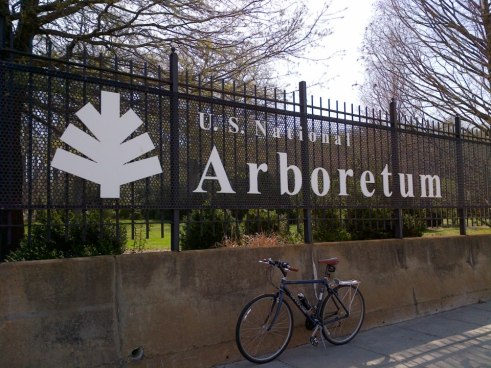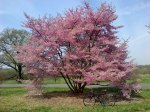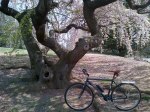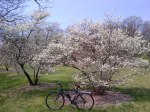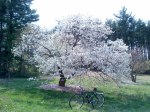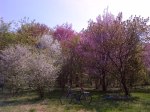I wrote last year in this blog about The Cherry Blossoms Around The Tidal Basin and along the Potomac River, but the spectacle of the thousands of trees at peak bloom is something that not only can but should be enjoyed every year. Unfortunately, the duration of the visual splendor of these delicate blooms is available for only a brief time, leading many to say that they are symbolic and serve to remind us of the beauty and brevity of life. Sadly, this year’s blossoms peaked earlier this week and are now gone. The wind and rain of the past few days have caused the trees to lose their blooms, forcing us to wait until next year to again experience the annual spectacle. However, in the meantime, I hope you will enjoy these photos (you can click on the photos to enlarge them and see them in their full size) which I took during my lunchtime bike rides during the past week. As you do, think about the bright white and pink flowers which seem to be illuminated by the sunlight. Try to imagine their subtle yet sweet fragrance in the early morning hours as you watch the sun rise on the other side of The Washington Monument. Picture yourself sitting on one of the many park benches next to the twisted and gnarled trunk of one of the trees, while petals from the fleeting blossoms fall all around you. Think about walking under the trees’ low hanging limbs while you traverse the waterside walkway surrounding the Tidal Basin. And imagine the feel of a gentle breeze as you enjoy the rows of trees lining the trails and roads along the river. Try to imagine these things and you’ll probably understand why I enjoy riding my bike around the city to enjoy the cherry trees, as well as all of the other attractions and experiences this area has to offer.
Posts Tagged ‘cherry blossoms’
The Annual Cherry Blossoms
Posted: April 16, 2015 in Events, Gardens, Roadside AttractionsTags: cherry blossoms, D.C., Potomac River, The Tidal Basin, Tidal Basin, West Potomac Park
The Cherry Blossoms Around The Tidal Basin
Posted: April 13, 2014 in Destinations, Events, ParksTags: cherry blossoms, Cherry Trees, D.C., Department of Agriculture, East Potomac Park, First Lady Helen Taft, President William Howard Taft, Somei-Yoshino, The Tidal Basin, West Potomac Park, Yoshino
Of the numerous and varied attractions worth visiting in D.C. and the surrounding area, most are permanent fixtures. The monunments and memorials, the statues and museums, the buildings and parks – all are available and routinely visited year round. But one of the capitol city’s biggest attractions is one of the few that is temporary in nature. Occurring for only a few days each spring, the blooming of the cherry trees surrounding the Tidal Basin is one of the biggest attractions in the city, bringing in visitors from around the country and around the world.
The cherry trees have been a fixture in D.C. for just over a century, but not as long as originally planned. In the summer of 1909, the Embassy of Japan informed the U.S. Department of State that the city of Tokyo intended to donate 2,000 cherry trees to the United States. However, when the trees arrived the following year, the inspection team from the Department of Agriculture found that the trees were infested with insects and roundworms, and recommended that the trees be destroyed. President William Howard Taft subsequently gave the order to burn the trees.
Two years later, a total of 3,020 replacement cherry trees consisting of 12 different species were shipped on Valentines Day, and subsequently arrived in D.C. on March 26. In a ceremony the following day, First Lady Helen Taft and the wife of the Japanese ambassador planted the first two of these trees on the north bank of the Tidal Basin in West Potomac Park. Today, these original two trees still stand at the terminus of 17th Street Southwest, marked by a large plaque. A few years later, the United States government responded with a gift of flowering dogwood trees to the people of Japan.
From 1913 to 1920, trees of the Somei-Yoshino variety, which comprised 1800 of the gift, were planted around the Tidal Basin. Trees of the other 11 species, and the remaining Yoshinos, were planted in East Potomac Park. In 1965, Japan gifted additional Yoshino trees, many of which were subsequently planted on the grounds of The Washington Monument. Since then, the number of trees has expanded to approximately 3,750 trees of 16 species in three National Park Service locations – the Tidal Basin in West Potomac Park, East Potomac Park, and on the grounds of the Washington Monument.
The Japanese Stone Lantern
Posted: April 12, 2014 in Artwork, StatuesTags: cherry blossoms, D.C., Japanese Stone Lantern, Japanese Stone Lantern Lighting Ceremony, National Cherry Blossom Festival, National Register of Historic Places, Taitō, third shogun of Tokugawa dynasty, Tidal Basin, Tokugawa dynasty, Tokugawa Iemitsu, Tokyo, Treaty of Amity and Friendship, Tōshō-gū temple, Ueno district, Ueno Park, West Potomac Park
In 1651, a pair of stone lanterns were created to mark the death of Tokugawa Iemitsu, the third shogun of Japan’s Tokugawa dynasty. The carved stone lanterns were originally located at the Tōshō-gū temple, and then in Ueno Park in the Ueno district of Taitō, Tokyo, where one of the twin lanterns still remains. The other lantern was given, by the governor of Tokyo, to the City of Washington as a gift in 1954, to commemorate the signing of the 1854 Japan-US Treaty of Amity and Friendship, and as a post-World War II symbol of friendship and peace between Japan and the people of United States.
The gifted lantern was dedicated on March 30, 1954, and is located among the Somei-Yoshino cherry trees which surround the Tidal Basin in West Potomac Park, which were an earlier gift from Japan. The stone lantern sits on north side of the Tidal Basin, at the west end of Kutz Bridge at Independence Avenue and 17th Street (MAP). The lantern is listed on the National Register of Historic Places, and serves as the historic centerpiece of the annual Cherry Blossom Festival, an event that attracts more than 1.5 million visitors to experience the blooming of the historic cherry trees and the welcoming of spring in our nation’s capitol.
A landscape enhancement project resulted in the addition of a granite plaza with natural stone boulders, and a memorial plaque commemorating the 1912 gift of the cherry trees, was completed on the grounds surrounding the lantern in 2013 . It is here that the Japanese Stone Lantern Lighting Ceremony, a formal ceremonial lighting of the lantern, is held during the annual National Cherry Blossom Festival. The ceremony is free and open to the public, and can be an integral part of the cherry blossom festival experience. But whether or not you are able to attend the lighting ceremony, the Japanese stone lantern is worth seeking out and visiting as part of the cherry blossom experience.
The Cherry Trees Collection at the National Arboretum
Posted: April 11, 2014 in Destinations, ParksTags: Afterglow Cherry, Akebono Cherry, Autumn Flowering Cherry, cherry blossoms, East Potomac Park, Fugenzo Cherry, Kwanzan Cherry, National Arboretum, Okame Cherry, Sargent Cherry, Shirofugen Cherry, Takesimensis Cherry, Tidal Basin, U.S. National Arboretum, Usuzumi Cherry, Weeping Japanese Cherry, Yoshino Cherry
In 1912, the people of Japan sent 3,020 cherry trees to the U.S. as a gift of friendship. Those trees were planted around the Tidal Basin in D.C. Since that time, when people in this country hear the words “cherry blossom,” they often think of the trees made famous by that historic planting. There are now approximately 3,750 trees. In addition to the Tidal Basin, they are located nearby in East Potomac Park and on the grounds of The Washington Monument as well. When it comes to cherry trees, the area near the Tidal Basin is definitely the place to go for quantity.
Although most of the cherry trees around the Tidal Basin area are the familiar Yoshino Cherry, there are 11 other species there as well. They are the Kwanzan Cherry, Akebono Cherry, Takesimensis Cherry, Usuzumi Cherry, Weeping Japanese Cherry, Sargent Cherry, Autumn Flowering Cherry, Fugenzo Cherry, Afterglow Cherry, Shirofugen Cherry and Okame Cherry. However, there are also numerous other species of these ornamental Prunus that offer a diversity of flower color, bloom time, and shape. So on a recent bike ride I went to the United States National Arboretum in northeast D.C. to see some of these trees that are not available downtown. The Arboretum has all 12 of the cherry tree species that are downtown, as well as 64 more. And the cherry trees at the National Arboretum are incredible specimens. So if you’re looking for quality and variety, I recommend the National Arboretum.
The National Arboretum displays 446 acres of different trees, shrubs and plants and is one of the largest arboretums in the country. Visitors enjoy a variety of exhibits from formal landscaped gardens to the Gotelli Dwarf and slow growing Conifer Collection. The National Arboretum is most known for its bonsai collection. Other special displays include seasonal exhibits, aquatic plants, and a National Herb garden. However, during this time of year, the site is an excellent but relatively little-known spot to see cherry trees. They currently have 76 varieties of cherry trees in the research and display collections there. And you can take a self-guided, self-paced tour and explore the acres of flowering cherry trees by bike, by foot, or by car.
The tour, aptly named the “Beyond the Tidal Basin Tour,” introduces visitors to a wide range of flowering cherries. You can see flowers in peak bloom on only some of the trees though, as different types of cherry trees have different bloom times. Many of the trees are in full bloom, but there are some that have already bloomed this season and lost their petals, while others are only beginning to bud. You should be aware that cherry trees have other ornamental features, such as trunk shape or ornamental bark, so be sure to look at the whole tree so you can appreciate the differing qualities as well as the different blooms.
For centuries, the Japanese have valued the ornamental qualities of flowering cherries, equating the transient beauty of the blossoms with the brevity of human life. I’d encourage everyone to visit the National Arboretum at some point in their life. And life is short, so don’t put it off for too long. It’s okay if you can’t come in the Spring to see the cherry trees. It’s worth coming at any time of the year.
















